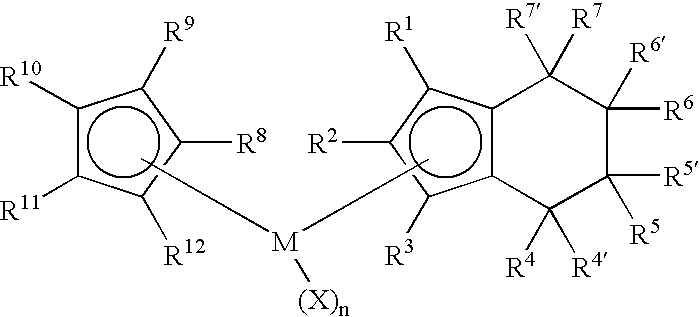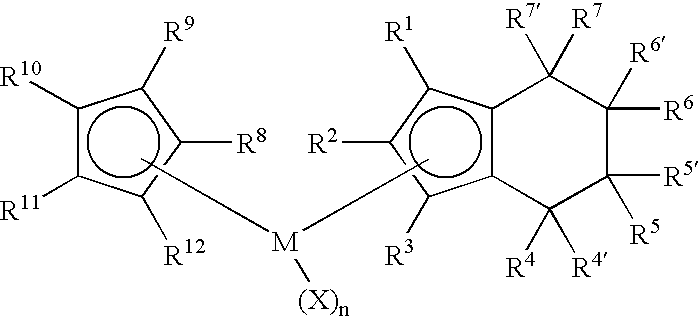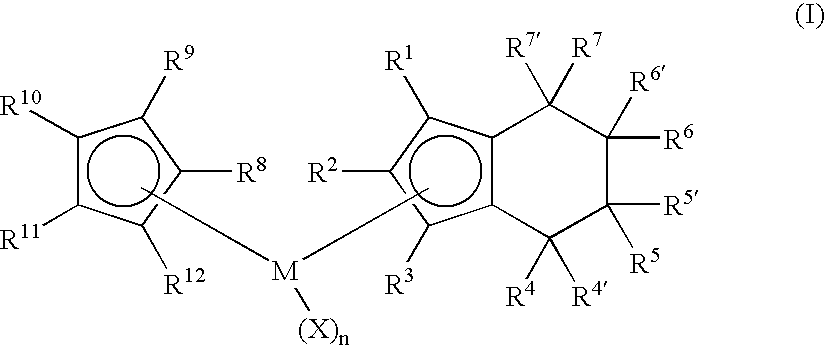Class of metallocenes and method of producing polyethylene
a metallocene and polyethylene technology, applied in the field of metallocenes, can solve the problems of relative complexity and cost of manufacturing such compounds, unsatisfactory changes in other resin properties, and the relative complexity of metallocenes
- Summary
- Abstract
- Description
- Claims
- Application Information
AI Technical Summary
Benefits of technology
Problems solved by technology
Method used
Image
Examples
example 1
Preparation of Cyclopentadienyl(tetrahydroindenyl)zirconium dichloride. Cp(H4Ind)ZrCl2
[0065]To a yellow solution of cyclopentadienyl(indenyl)zirconium dichloride (2.00 g, 5.84 mmol) in dichloromethane (40 mL) was added PtO2 (0.20 g, 10 wt %) to give a dirty yellow mixture. The mixture was stirred and pressurized with 80 psi H2. After stirring 2 hours with 80 psi H2 the solution was nearly colorless. The hydrogen was then vented and the reaction was filtered through celite to give black solid and a pale straw-yellow colored solution. The solution was evaporated in vacuo, leaving white solid. Yield 1.69 g (84%). 1H NMR(CD2Cl2): δ 1.60-1.81 (m, 4H, ring H of H4Ind), 2.50-2.59 (m, 2H, ring H of H4Ind), 2.76-2.85 (m, 2H, ring H of H4Ind), 5.80 (m, 2H, Cp-H of H4Ind), 6.37 (m, 1H, Cp-H of H4Ind), 6.44 (s, 5H, Cp).
[0066]Comparative Example 1. Cyclopentadienyl(indenyl)zirconium dichloride was purchased from Boulder Scientific Co. and used as received.
example 2
Preparation of Cyclopentadienyl(1-methyltetrahydroindenyl)zirconium dichloride. Cp(1-MeH4Ind)ZrCl2
[0067]To a bright yellow solution of Cp(1-MeInd)ZrCl2 (1.07 g, 3.00 mmol) in dichloromethane (25 mL) was added PtO2 (0.10 g, 10 wt %) to give a dirty yellow mixture. The mixture was stirred and pressurized with 80 psi H2. After stirring 45 minutes with 80 psi H2 the solution was gray-black. The hydrogen was then vented and the reaction was filtered through celite to give black solid and a pale greenish solution. The solution was evaporated in vacuo, leaving white solid. Yield 0.95 g (88%). 1H NMR(CD2Cl2): δ 1.60-1.78 (m, 4H, ring H of H4Ind), 1.96 (s, 3H, Me), 2.34-2.56 (m, 2H, ring H of H4Ind), 2.72-2.82 (m, 2H, ring H of H4Ind), 5.69 (d, 1H, Cp-H of H4Ind), 6.14 (d, 1H, Cp-H of H4Ind), 6.41 (s, 5H, Cp).
example 3
Preparation of (1,3-Dimethylcyclopentadienyl)(tetrahydroindenyl)zirconium dichloride. (1,3-Me2Cp)(H4Ind)ZrCl2
[0069]To a yellow solution of (1,3-Me2Cp)IndZrCl2 (0.80 g, 2.16 mmol) in dichloromethane (20 mL) was added PtO2 (0.08 g, 10 wt %) to give a dirty yellow mixture. The mixture was stirred and pressurized with 80 psi H2. After stirring 40 minutes with 80 psi H2 the solution was gray-black. The hydrogen was then vented and the reaction was filtered through celite to give black solid and a colorless solution. The solution was evaporated in vacuo, leaving white solid. The solid was washed with pentane (3×10 mL) and dried in vacuo. Yield 0.74 g (92%) white solid. 1H NMR(CD2Cl2): δ 1.52-1.65 (m, 2H, ring H of H4Ind), 1.72-1.90 (m, 2H, ring H of H4Ind), 2.18 (s, 3H, Me) 2.52-2.60 (m, 2H, ring H of H4Ind), 2.77-2.86 (m, 2H, ring H of H4Ind) 5.73 (d, 2H,), 6.31 (d, 2H), 6.07 (t, 1H), 6.29 (t, 1H).
PUM
| Property | Measurement | Unit |
|---|---|---|
| mole ratio | aaaaa | aaaaa |
| mole ratio | aaaaa | aaaaa |
| mole ratio | aaaaa | aaaaa |
Abstract
Description
Claims
Application Information
 Login to View More
Login to View More - R&D
- Intellectual Property
- Life Sciences
- Materials
- Tech Scout
- Unparalleled Data Quality
- Higher Quality Content
- 60% Fewer Hallucinations
Browse by: Latest US Patents, China's latest patents, Technical Efficacy Thesaurus, Application Domain, Technology Topic, Popular Technical Reports.
© 2025 PatSnap. All rights reserved.Legal|Privacy policy|Modern Slavery Act Transparency Statement|Sitemap|About US| Contact US: help@patsnap.com



